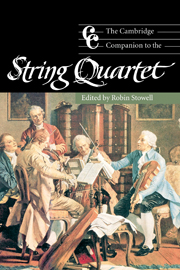3 - From chamber to concert hall
from Part II - Celebrated ensembles
Published online by Cambridge University Press: 28 September 2011
Summary
Although the first full-time professional string quartet ensemble did not emerge until 1892, the nineteenth century saw a steady improvement in the standard of quartet playing. Several trends can be seen running through the century as a whole: a gradual strengthening of the actual sound emitted by the players; the emergence of Beethoven as the recognised king of quartet composers; and the espousal of the heritage or museum-style concert in which music of a previous age was presented. The last two of these developments were largely precipitated by Joseph Joachim (1831–1907), whose giant personality cast its shadow over the second half of the century.
The sound of the quartet
It is possible to make an informed guess at the kind of sonority produced by a typical string quartet ensemble at the start of the century. With rare exceptions, quartets were played in large rooms rather than halls, and there was no need to strive for a powerful sound. The tone of even the top violin soloists was not large. Bows had reached their evolutionary peak but most instruments still had their original shorter necks and the fingerboards ran more parallel with the bodies, so that the gut strings were under relatively light pressure.
Full-time violists were unknown, although the Stamitz brothers both played the instrument to a high standard, and the viola in a quartet would invariably be played by a violinist who would adapt violin technique to a smallish instrument and would therefore make a quite narrow, nasal sound. The cello had no endpin and the cellist held it resting on his lower legs, partially muffling the tone. Although there is not complete agreement on how much vibrato was generally applied, it is likely that, especially in quartet music, the effect was used sparingly, like an ornament, and never in chordal passages. We therefore have in our mind’s ear a quite small, delicate, ‘straight’ sonority which various twentieth- and twenty-first-century period-instrument groups have striven to reproduce, with varying success.
- Type
- Chapter
- Information
- The Cambridge Companion to the String Quartet , pp. 39 - 59Publisher: Cambridge University PressPrint publication year: 2003
- 1
- Cited by

